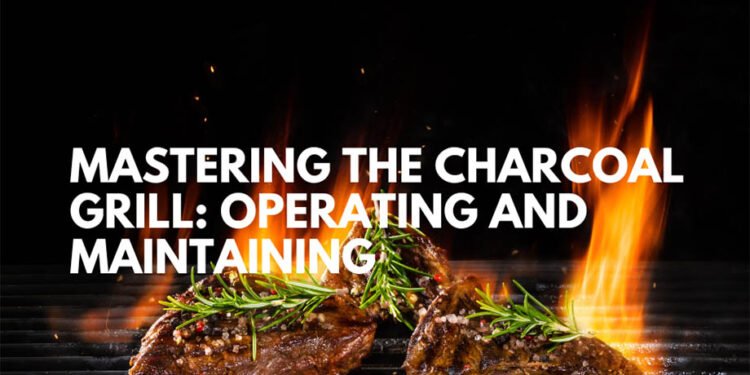A charcoal grill stands as an essential apparatus for those who relish outdoor culinary pursuits, esteemed for its knack for imbuing dishes with an inimitable smoky essence. Diverging from gas grills that depend on propane or natural gas, charcoal grills harness charcoal briquettes or lump charcoal as their predominant fuel source. This traditional method of grilling offers a unique culinary experience, perfect for backyard barbecues, camping trips, or tailgating gatherings.
In addition to their diverse sizes and styles, charcoal grills commonly offer adjustable air vents, facilitating control over airflow and temperature. This feature enables precise heat regulation, granting users versatility in cooking techniques. Moreover, replacement grill grates are readily available for charcoal grills.
Discover more about different kinds of charcoal grills and how to operate them
Even if you’re grilling steaks, burgers, or chops, using a charcoal grill adds a distinct smokiness that gas grills simply can’t match. Initially, newcomers to charcoal grilling might find the process daunting.
There’s the consideration of charcoal quantity, igniting the grill, and adjusting the vent based on the grill’s internal temperature. It’s also advisable to familiarize yourself with the different components of a charcoal grill and learn proper grill shutdown procedures before starting your cooking session using this method.
When comparing charcoal grilling to gas grilling, it’s evident that mastering the art of starting a charcoal grill and regulating its temperature through vents or dampers requires a more hands-on approach than simply adjusting temperature dials and igniting a switch.
Nevertheless, with the aid of this informative guide, you’ll uncover the techniques for utilizing a charcoal grill while also gaining valuable insights into key tips for charcoal grilling.
Crucial Parts for Charcoal Grills
Common parts for charcoal grills include the grill grates, burners, gas knobs, cooking surface, and wheels. Selecting compatible components is essential to uphold the operational efficiency and safety of the grill.
Before delving into the intricacies of using a charcoal grill effectively, it’s essential to familiarize oneself with its primary components and their respective roles.
- Firebox: The firebox is where the charcoal and flames are contained at the base of the grill, facilitating the cooking process.
- Vents: Vents, including those situated at the top, bottom, and occasionally on the sides, serve to regulate airflow within the grill, thereby managing its internal temperature.
- Cook chamber: Within the cook chamber, there exists a designated area for the grill grate, strategically placing the food directly over the flame emanating from the firebox situated below.
- Lid: The lid, an integral part of the charcoal grill, aids in temperature control through an adjustable top vent mechanism.
Charcoal Grill Types You Should Know
Seize the chance to delve into the wide range of charcoal grill varieties on offer, each showcasing unique attributes and qualities tailored to diverse tastes and requirements.
By delving into the nuances of kettle, barrel, ceramic, hibachi, and portable grills, you can gain valuable insights into their individual strengths and weaknesses, facilitating an informed decision on selecting the ideal charcoal grill for your home.
1. Kettle grills:
A timeless choice, feature a rounded steel chamber typically supported by either three or four legs, making them suitable for small family gatherings, though potentially insufficient for larger backyard barbecues.
These grills often incorporate vents both in the lid and at the base of the firebox, enabling precise airflow control for quicker burger grilling, with cooking times ranging from two to six minutes, depending on desired doneness.
Example : 363-square-inch cooking surface and a convenient ash-collection system designed for effortless cleaning, the Weber Original Kettle Premium Grill stands out as a top choice for outdoor cooking enthusiasts. Additionally, the Weber original kettle premium grill offers weber grill grates option for a replacement grill grates.
2. Barrel grills:
An example of this style of grill might resemble a steel drum positioned horizontally, precisely split down the center. One half serves as a lid, while the other forms the main body of the grill.
Typically, the lid features a customizable vent or damper, sometimes equipped with a built-in temperature gauge. Inside the core structure of the grill, you’ll encounter distinct components such as the firebox, cooking chamber, cooking grate, and a customizable bottom vent or side vents, enabling meticulous regulation of temperatures while grilling.
Example: Char-Grill E-3101 Extra-Wide Charcoal Grill: This grill is perfect for outdoor cookouts and features a charcoal grilling surface and extra-wide cooking surface.
3. Ceramic grills:
Ceramic grills, aptly named for their composition of ceramic materials, boast a distinctive ability to heat up gradually yet retain and emit heat far longer than their conventional steel counterparts.
This unique characteristic renders them exceptionally suited for the slow, low-temperature smoking of foods. Moreover, their slender, egg-shaped design serves to minimize direct airflow onto the food being grilled, thus preserving its moisture throughout the cooking process.
Example: Akorn kamado charcoal grill typically surpasses a conventional gas grill in performance. Despite requiring some initial skill development and often carrying a higher price tag, investing in a kamado grill is unquestionably worthwhile. Renowned for their wood-fired cooking capabilities, kamado grills offer unparalleled flavor and versatility on the grill.
4. Hibachi grills:
Hibachi grills represent a distinct category of portable charcoal grills distinguished by their design, as they do not necessitate the use of a lid or vents for heat regulation.
Compact in size, these grills typically incorporate one or more cast-iron grates positioned above a metal chamber functioning as the firebox. Their compactness renders them effortlessly transportable, making them convenient for packing into a vehicle for camping trips or for setting up at tailgate gatherings.
Example: Cuisinart GED-450LS: This Hibachi grill is great for both indoor and outdoor cooking.
5. Portable Charcoal Grill:
When planning a local park outing or preparing for a trip, having a compact, portable charcoal grill that conveniently fits in the trunk of a car is invaluable. Portable charcoal grills typically offer a smaller grilling area due to their emphasis on portability, making them less suitable for large gatherings or parties.
Additionally, these grills often boast useful characteristics such as foldable legs, integrated carrying handles, and built-in tabletop stands, ensuring they can be placed on a surface without causing damage from heat.
Example: The Coleman RoadTrip 285 Propane Grill boasts a generous grilling surface of 285 square inches, making it an ideal choice for picnics and barbecues alike. Its lightweight design and portability render it a convenient option for backyard get-togethers and outdoor gatherings of all kinds.
Maintenance Advice for Charcoal Grills
Regular maintenance is essential for preserving the condition of your grill. It’s recommended to give your grill a thorough cleaning at least once per season, either before storing it away or at the start of the grilling season. How to clean grill grates and grill?
Start by removing the grill grates and applying an appropriate cleaner to both the interior and exterior of the grill. Utilize a soft-bristled brush to gently remove any built-up grease, charcoal remnants, or dirt. Ensure to clear out the firebox and ash receptacle after the coals and ashes have fully cooled, although this may require waiting a few days.
Following each grilling session, it’s recommended to promptly tidy up the grill grates and cooking chamber to eliminate any residual food particles, sauces, or grease.
Hope the information about use of Charcoal grill is helpful!
FAQs:
How often should I clean my charcoal grill?
Clean your grill after every use to prevent the buildup of food particles and grease.
How do I start a charcoal fire?
Start a charcoal fire by pouring lighter fluid on the charcoal and letting it burn for a few minutes until it turns white hot.
What temperature do I grill chicken at?
Grill chicken at a temperature of 350-400°F for best results.
Should I use hardwood or softwood charcoal?
Softwood charcoal is easier to light and burns hot












